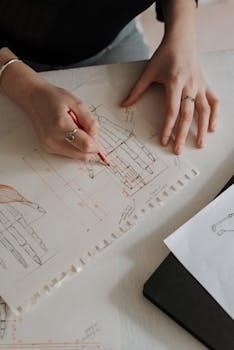Plan Drawings Overview
Plan drawings are essential in architecture‚ presenting a view from above on a horizontal plane. They depict the layout of a space‚ showcasing the arrangement of walls‚ doors‚ and other elements. These drawings are typically scaled‚ offering a clear understanding of spatial relationships.
Definition of a Plan Drawing
A plan drawing‚ fundamentally‚ is a scaled representation of a space viewed directly from above‚ as if looking down on a cut-away model. It’s a two-dimensional diagram that captures the horizontal arrangement of elements within a structure or area. This type of drawing is crucial in architecture and construction because it provides a clear overview of the layout and spatial relationships. Unlike elevation drawings‚ which show the vertical faces of a building‚ plan drawings focus on the floor plan‚ depicting the position of walls‚ doors‚ windows‚ and internal features. They serve as a fundamental tool for architects and designers to communicate their concepts‚ manage space‚ and ensure the functionality of a structure or site. These plans are typically created using a standard metric scale‚ such as 1⁚50 or 1⁚100. The plan often includes a north point.
Horizontal Plane View
The horizontal plane view‚ inherent in plan drawings‚ offers a distinct perspective by showcasing a space as if it were sliced horizontally. This viewpoint allows for a detailed understanding of spatial organization and the arrangement of elements within a structure. Looking down from above‚ we can clearly see how rooms connect‚ how furniture is placed‚ and the overall flow of the space. This top-down view is instrumental in planning layouts and understanding how a structure will function in real life. It is the foundation for other drawings like elevations and sections. The horizontal plane view provides a bird’s-eye perspective‚ making it easy to understand the relationships between different components. It is an essential tool for architects in the design process‚ giving a clear and precise way to communicate the intended use of space.

Elevation Drawings Overview
Elevation drawings present a building’s exterior from a vertical perspective. They illustrate the building’s appearance‚ showcasing features‚ dimensions‚ and aesthetic design. These drawings provide a comprehensive external view.
Definition of an Elevation Drawing
An elevation drawing‚ in the realm of architectural and engineering design‚ serves as a crucial visual representation of a structure’s exterior. Unlike plan drawings‚ which offer a bird’s-eye view‚ an elevation drawing depicts a building or object from a specific side‚ as if viewed directly from the ground. This type of drawing is essential for conveying the vertical dimensions‚ architectural details‚ and overall appearance of the structure. It provides a flat‚ two-dimensional view of one of the building’s faces‚ be it the front‚ rear‚ or sides. Furthermore‚ elevation drawings are indispensable for understanding the visual aspects of a design‚ helping stakeholders visualize the final product‚ and for communicating design intentions effectively to construction teams. They are carefully scaled to maintain accuracy‚ ensuring that all features are represented proportionally.
Vertical Plane Depiction
Elevation drawings are fundamentally characterized by their depiction on a vertical plane. This means they present a side view of a structure‚ as opposed to the top-down perspective of a plan drawing. This vertical plane depiction is crucial for visualizing the height‚ proportions‚ and exterior detailing of a building. The vertical plane allows architects and designers to accurately show how the building will appear when viewed from ground level‚ highlighting the facade‚ rooflines‚ windows‚ and doors. This view is essential for understanding the building’s relationship with its surroundings and for planning the building’s exterior aesthetics. The use of a vertical plane in elevation drawings provides a clear and concise way to represent the building’s exterior dimensions‚ enabling accurate construction and design communication.

Exterior Building Appearance
Elevation drawings are primarily used to illustrate the exterior appearance of a building. They provide a detailed view of the facade‚ showing the arrangement of windows‚ doors‚ and other architectural features. These drawings are crucial for understanding the building’s aesthetic qualities and how it will look in its surroundings. The elevations depict the materials used on the exterior‚ such as brick‚ siding‚ or glass‚ and showcase the building’s overall style. They also help to visualize the relationship between different parts of the exterior‚ ensuring a cohesive design. The accuracy of these drawings is critical for both design and construction purposes‚ as they guide the creation of the building’s visible form.
Four Main Elevations
Typically‚ a complete set of elevation drawings includes four main views‚ representing each side of the structure. These are the front‚ rear‚ left side‚ and right side elevations. Each elevation provides a unique perspective on the building’s exterior‚ allowing for a comprehensive understanding of its design. The front elevation often showcases the main entrance and the most prominent features‚ while the rear elevation may depict service areas. The side elevations present the building from different angles‚ highlighting its depth and proportions. Together‚ these four elevations create a complete picture of the building’s outward appearance‚ crucial for design‚ planning‚ and construction.

Section Drawings Overview
Section drawings provide a view of a structure as if it were sliced vertically. This reveals internal details‚ showing how spaces connect and the construction of elements like walls and floors.
Definition of a Section Drawing
A section drawing‚ in architectural and engineering contexts‚ is a specific type of orthographic projection that represents a structure as if it were cut through by a vertical plane. Imagine taking a knife and slicing directly through a building; a section drawing is the depiction of that cut. It is distinct from a plan drawing‚ which shows a view from above‚ and an elevation drawing‚ which presents an exterior view. The purpose of a section drawing is to expose the interior construction of a building or object‚ revealing details such as wall thickness‚ floor heights‚ and the relationship between different levels. It provides crucial information for understanding the vertical organization and structural composition of the design. This view is essential for conveying how the various components of a structure fit together.
Vertical Cut Through Space
The concept of a vertical cut through space is central to understanding section drawings. Unlike plan views that show a structure from above‚ or elevations which depict exterior facades‚ a section drawing is created by imagining a vertical plane slicing through the building. This theoretical cut allows architects and engineers to visualize the interior configuration‚ revealing elements that would otherwise be hidden. By projecting what’s visible on the imaginary cut surface‚ the drawing provides information about wall constructions‚ floor levels‚ and the spatial relationship of interior components. This ‘cut’ is not an actual physical cut but rather a method of representation used to convey critical information. The resulting section view allows for a detailed understanding of the building’s inner structure‚ which is vital for construction planning and design analysis. The vertical nature of this cut is the very definition of a section view.
Revealing Interior Details
Section drawings are instrumental in revealing the intricate interior details of a structure. They go beyond the external appearance shown in elevations‚ providing a glimpse into the building’s internal workings. By depicting a vertical cut through the space‚ these drawings expose the construction materials‚ layering of floors and ceilings‚ and the relationship between different rooms. They showcase the hidden aspects of a design‚ such as the height of spaces‚ the thickness of walls‚ and the presence of structural elements. This detailed view is invaluable for understanding the physical composition of a building‚ aiding in construction planning and the resolution of design challenges. The precise information conveyed in sections ensures a clear representation of interior characteristics‚ essential for contractors and stakeholders alike to grasp the intent of the architect. Such a level of detail is not visible in plan or elevation drawings.

Scales and Standards
Architectural drawings adhere to standard metric scales‚ like 1⁚50 or 1⁚100‚ ensuring accurate representations. These scales are crucial for consistent communication and proper dimensioning of designs.
Standard Metric Scales
In the realm of architectural and engineering drawings‚ the utilization of standard metric scales is paramount for ensuring clarity‚ accuracy‚ and consistency. These scales‚ typically expressed as ratios‚ establish the relationship between the dimensions depicted on a drawing and the corresponding measurements of the actual object or structure. Common metric scales‚ such as 1⁚50 and 1⁚100‚ are frequently employed for plan drawings‚ allowing for a manageable representation of buildings and spaces on paper. A scale of 1⁚50 indicates that one unit on the drawing corresponds to 50 units in reality‚ while 1⁚100 means one unit on the drawing equals 100 units in the physical world. These standard scales enable architects‚ engineers‚ and construction professionals to accurately interpret and execute designs‚ facilitating seamless collaboration and project implementation. The use of these scales ensures that all parties involved have a shared understanding of the project’s dimensions and proportions‚ minimizing errors and misunderstandings throughout the design and construction process. Furthermore‚ the use of metric scales promotes international standardization‚ allowing for the easy sharing and interpretation of drawings across different regions and countries.

Leave a Reply
You must be logged in to post a comment.